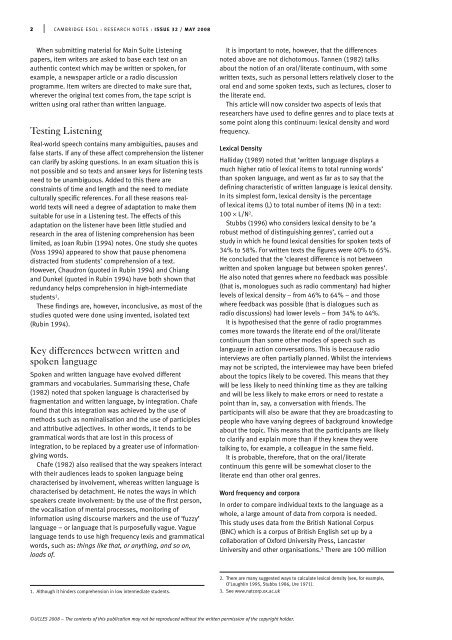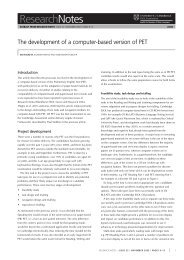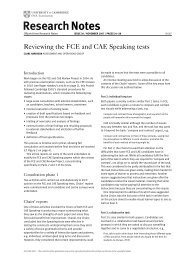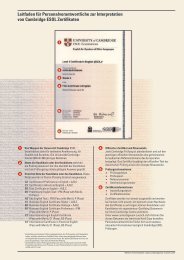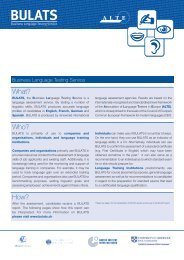Vocabulary use in the FCE Listening test - Cambridge English Exams
Vocabulary use in the FCE Listening test - Cambridge English Exams
Vocabulary use in the FCE Listening test - Cambridge English Exams
You also want an ePaper? Increase the reach of your titles
YUMPU automatically turns print PDFs into web optimized ePapers that Google loves.
2 | CAMBRIDGE ESOL : RESEARCH NOTES : ISSUE 32 / MAY 2008When submitt<strong>in</strong>g material for Ma<strong>in</strong> Suite Listen<strong>in</strong>gpapers, item writers are asked to base each text on anau<strong>the</strong>ntic context which may be written or spoken, forexample, a newspaper article or a radio discussionprogramme. Item writers are directed to make sure that,wherever <strong>the</strong> orig<strong>in</strong>al text comes from, <strong>the</strong> tape script iswritten us<strong>in</strong>g oral ra<strong>the</strong>r than written language.Test<strong>in</strong>g Listen<strong>in</strong>gReal-world speech conta<strong>in</strong>s many ambiguities, pa<strong>use</strong>s andfalse starts. If any of <strong>the</strong>se affect comprehension <strong>the</strong> listenercan clarify by ask<strong>in</strong>g questions. In an exam situation this isnot possible and so texts and answer keys for listen<strong>in</strong>g <strong>test</strong>sneed to be unambiguous. Added to this <strong>the</strong>re areconstra<strong>in</strong>ts of time and length and <strong>the</strong> need to mediateculturally specific references. For all <strong>the</strong>se reasons realworldtexts will need a degree of adaptation to make <strong>the</strong>msuitable for <strong>use</strong> <strong>in</strong> a Listen<strong>in</strong>g <strong>test</strong>. The effects of thisadaptation on <strong>the</strong> listener have been little studied andresearch <strong>in</strong> <strong>the</strong> area of listen<strong>in</strong>g comprehension has beenlimited, as Joan Rub<strong>in</strong> (1994) notes. One study she quotes(Voss 1994) appeared to show that pa<strong>use</strong> phenomenadistracted from students’ comprehension of a text.However, Chaudron (quoted <strong>in</strong> Rub<strong>in</strong> 1994) and Chiangand Dunkel (quoted <strong>in</strong> Rub<strong>in</strong> 1994) have both shown thatredundancy helps comprehension <strong>in</strong> high-<strong>in</strong>termedia<strong>test</strong>udents 1 .These f<strong>in</strong>d<strong>in</strong>gs are, however, <strong>in</strong>conclusive, as most of <strong>the</strong>studies quoted were done us<strong>in</strong>g <strong>in</strong>vented, isolated text(Rub<strong>in</strong> 1994).Key differences between written andspoken languageSpoken and written language have evolved differentgrammars and vocabularies. Summaris<strong>in</strong>g <strong>the</strong>se, Chafe(1982) noted that spoken language is characterised byfragmentation and written language, by <strong>in</strong>tegration. Chafefound that this <strong>in</strong>tegration was achieved by <strong>the</strong> <strong>use</strong> ofmethods such as nom<strong>in</strong>alisation and <strong>the</strong> <strong>use</strong> of participlesand attributive adjectives. In o<strong>the</strong>r words, it tends to begrammatical words that are lost <strong>in</strong> this process of<strong>in</strong>tegration, to be replaced by a greater <strong>use</strong> of <strong>in</strong>formationgiv<strong>in</strong>gwords.Chafe (1982) also realised that <strong>the</strong> way speakers <strong>in</strong>teractwith <strong>the</strong>ir audiences leads to spoken language be<strong>in</strong>gcharacterised by <strong>in</strong>volvement, whereas written language ischaracterised by detachment. He notes <strong>the</strong> ways <strong>in</strong> whichspeakers create <strong>in</strong>volvement: by <strong>the</strong> <strong>use</strong> of <strong>the</strong> first person,<strong>the</strong> vocalisation of mental processes, monitor<strong>in</strong>g of<strong>in</strong>formation us<strong>in</strong>g discourse markers and <strong>the</strong> <strong>use</strong> of ‘fuzzy’language – or language that is purposefully vague. Vaguelanguage tends to <strong>use</strong> high frequency lexis and grammaticalwords, such as: th<strong>in</strong>gs like that, or anyth<strong>in</strong>g, and so on,loads of.It is important to note, however, that <strong>the</strong> differencesnoted above are not dichotomous. Tannen (1982) talksabout <strong>the</strong> notion of an oral/literate cont<strong>in</strong>uum, with somewritten texts, such as personal letters relatively closer to <strong>the</strong>oral end and some spoken texts, such as lectures, closer to<strong>the</strong> literate end.This article will now consider two aspects of lexis thatresearchers have <strong>use</strong>d to def<strong>in</strong>e genres and to place texts atsome po<strong>in</strong>t along this cont<strong>in</strong>uum: lexical density and wordfrequency.Lexical DensityHalliday (1989) noted that ‘written language displays amuch higher ratio of lexical items to total runn<strong>in</strong>g words’than spoken language, and went as far as to say that <strong>the</strong>def<strong>in</strong><strong>in</strong>g characteristic of written language is lexical density.In its simplest form, lexical density is <strong>the</strong> percentageof lexical items (L) to total number of items (N) <strong>in</strong> a text:100 × L/N 2 .Stubbs (1996) who considers lexical density to be ‘arobust method of dist<strong>in</strong>guish<strong>in</strong>g genres’, carried out astudy <strong>in</strong> which he found lexical densities for spoken texts of34% to 58%. For written texts <strong>the</strong> figures were 40% to 65%.He concluded that <strong>the</strong> ‘clearest difference is not betweenwritten and spoken language but between spoken genres’.He also noted that genres where no feedback was possible(that is, monologues such as radio commentary) had higherlevels of lexical density – from 46% to 64% – and thosewhere feedback was possible (that is dialogues such asradio discussions) had lower levels – from 34% to 44%.It is hypo<strong>the</strong>sised that <strong>the</strong> genre of radio programmescomes more towards <strong>the</strong> literate end of <strong>the</strong> oral/literatecont<strong>in</strong>uum than some o<strong>the</strong>r modes of speech such aslanguage <strong>in</strong> action conversations. This is beca<strong>use</strong> radio<strong>in</strong>terviews are often partially planned. Whilst <strong>the</strong> <strong>in</strong>terviewsmay not be scripted, <strong>the</strong> <strong>in</strong>terviewee may have been briefedabout <strong>the</strong> topics likely to be covered. This means that <strong>the</strong>ywill be less likely to need th<strong>in</strong>k<strong>in</strong>g time as <strong>the</strong>y are talk<strong>in</strong>gand will be less likely to make errors or need to restate apo<strong>in</strong>t than <strong>in</strong>, say, a conversation with friends. Theparticipants will also be aware that <strong>the</strong>y are broadcast<strong>in</strong>g topeople who have vary<strong>in</strong>g degrees of background knowledgeabout <strong>the</strong> topic. This means that <strong>the</strong> participants are likelyto clarify and expla<strong>in</strong> more than if <strong>the</strong>y knew <strong>the</strong>y weretalk<strong>in</strong>g to, for example, a colleague <strong>in</strong> <strong>the</strong> same field.It is probable, <strong>the</strong>refore, that on <strong>the</strong> oral/literatecont<strong>in</strong>uum this genre will be somewhat closer to <strong>the</strong>literate end than o<strong>the</strong>r oral genres.Word frequency and corporaIn order to compare <strong>in</strong>dividual texts to <strong>the</strong> language as awhole, a large amount of data from corpora is needed.This study <strong>use</strong>s data from <strong>the</strong> British National Corpus(BNC) which is a corpus of British <strong>English</strong> set up by acollaboration of Oxford University Press, LancasterUniversity and o<strong>the</strong>r organisations. 3 There are 100 million1. Although it h<strong>in</strong>ders comprehension <strong>in</strong> low <strong>in</strong>termediate students.2. There are many suggested ways to calculate lexical density (see, for example,O’Loughl<strong>in</strong> 1995, Stubbs 1986, Ure 1971).3. See www.natcorp.ox.ac.uk©UCLES 2008 – The contents of this publication may not be reproduced without <strong>the</strong> written permission of <strong>the</strong> copyright holder.


